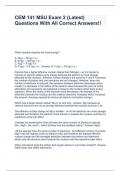Cem 141 msu exam 2 - Study guides, Class notes & Summaries
Looking for the best study guides, study notes and summaries about Cem 141 msu exam 2? On this page you'll find 16 study documents about Cem 141 msu exam 2.
All 16 results
Sort by
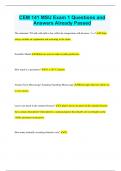 Popular
Popular
-
CEM 141 MSU Exam 1 Questions and Answers Already Passed
- Exam (elaborations) • 9 pages • 2024
- Available in package deal
-
- $9.99
- 1x sold
- + learn more
CEM 141 MSU Exam 1 Questions and Answers Already Passed The statement "If I add cold milk to hot coffee the temperature will decrease," is a? Claim, always include an explanation and reasoning to the claim. Scientific Model Models are used to make testable predictions How much is a picometer? 0.1 x 10^-12 meters Atomic Force Microscopy/ Scanning Tunneling Microscopy Microscopes that now allows us to view atoms. Leaves are green in the summer because? A plant's leaves are gree...
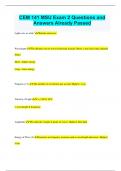
-
CEM 141 MSU Exam 2 Questions and Answers Already Passed
- Exam (elaborations) • 20 pages • 2024
- Available in package deal
-
- $9.99
- + learn more
CEM 141 MSU Exam 2 Questions and Answers Already Passed Lights acts as what? Particle and wave. Wavelength The distance (m) of waves from peak to peak. Short: x-ray (red), long: infrared (blue) Short - higher energy Long - lower energy Frequency (V) The number of wavefronts per second. Highest: x-ray Velocity of Light C = 3.00 X 10^8 = wavelength X frequency Amplitude The intensity, height of peaks of waves. Highest: blue light Energy of Wave (J) Increases as frequency i...
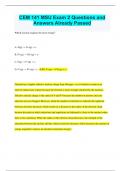
-
CEM 141 MSU Exam 2 Questions and Answers Already Passed
- Exam (elaborations) • 15 pages • 2024
- Available in package deal
-
- $9.99
- + learn more
CEM 141 MSU Exam 2 Questions and Answers Already Passed Which reaction requires the most energy? A. N(g) → N+(g) + e - B. N+(g) → N2+(g) + e - C. F(g) → F+(g) + e - D. F+(g) → F2+(g) + e - D. F+(g) → F2+(g) + e - Fluorine has a higher effective nuclear charge than Nitrogen - so it is harder to remove an electron (takes more energy because the electron is more strongly attracted by the nucleus). Effective nuclear charge is the same for F and F+ because the number of pro...
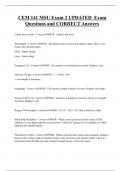
-
CEM 141 MSU Exam 2 UPDATED Exam Questions and CORRECT Answers
- Exam (elaborations) • 13 pages • 2024
-
- $9.49
- + learn more
CEM 141 MSU Exam 2 UPDATED Exam Questions and CORRECT Answers Lights acts as what? - Correct ANSWER- Particle and wave. Wavelength - Correct ANSWER- The distance (m) of waves from peak to peak. Short: x-ray (red), long: infrared (blue) Short - higher energy Long - lower energy Frequency (V) - Correct ANSWER- The number of wavefronts per second. Highest: x-ray Velocity of Light - Correct ANSWER- C = 3.00 X 10^8
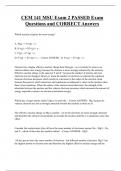
-
CEM 141 MSU Exam 2 PASSED Exam Questions and CORRECT Answers
- Exam (elaborations) • 10 pages • 2024
-
- $8.99
- + learn more
CEM 141 MSU Exam 2 PASSED Exam Questions and CORRECT Answers Which reaction requires the most energy? A. N(g) → N+(g) + e - B. N+(g) → N2+(g) + e - C. F(g) → F+(g) + e - D. F+(g) → F2+(g) + e - - Correct ANSWER- D. F+(g) → F2+(g) + e - Fluorine has a higher effective nuclear charge than Nitrogen - so it is harder to remove an electron (takes more energy because the electron is more strongly attracted by the nucleus). Effective nuclear charge is the same for F and F+ because...
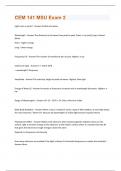
-
CEM 141 MSU Exam 2 Questions with 100% Correct Answers | Verified
- Exam (elaborations) • 12 pages • 2024
- Available in package deal
-
- $7.99
- + learn more
Lights acts as what? - Answer-Particle and wave. Wavelength - Answer-The distance (m) of waves from peak to peak. Short: x-ray (red), long: infrared (blue) Short - higher energy Long - lower energy Frequency (V) - Answer-The number of wavefronts per second. Highest: x-ray Velocity of Light - Answer-C = 3.00 X 10^8 = wavelength X frequency Amplitude - Answer-The intensity, height of peaks of waves. Highest: blue light Energy of Wave (J) - Answer-Increases as frequency increases and as wa...
CEM 141 MSU Exam 2 Questions And Answers Rated A+ New Update Assured Satisfaction
CEM 141 MSU Exam 2 (Latest) Questions With All Correct Answers!!
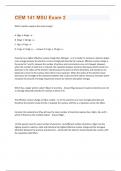
-
CEM 141 MSU Exam 2 Questions And Answers Rated A+ New Update Assured Satisfaction
- Exam (elaborations) • 9 pages • 2024
- Available in package deal
-
- $7.99
- + learn more
Which reaction requires the most energy? A. N(g) → N+(g) + e - B. N+(g) → N2+(g) + e - C. F(g) → F+(g) + e - D. F+(g) → F2+(g) + e - - Answer-D. F+(g) → F2+(g) + e - Fluorine has a higher effective nuclear charge than Nitrogen - so it is harder to remove an electron (takes more energy because the electron is more strongly attracted by the nucleus). Effective nuclear charge is the same for F and F+ because the number of protons and core electrons are not changed. However, when t...
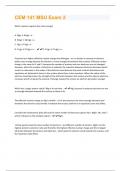
-
CEM 141 MSU Exam 2 Questions With Correct Answers Already Passed!!
- Exam (elaborations) • 9 pages • 2023
- Available in package deal
-
- $7.89
- + learn more
Which reaction requires the most energy? A. N(g) → N+(g) + e - B. N+(g) → N2+(g) + e - C. F(g) → F+(g) + e - D. F+(g) → F2+(g) + e - - D. F+(g) → F2+(g) + e - Fluorine has a higher effective nuclear charge than Nitrogen - so it is harder to remove an electron (takes more energy because the electron is more strongly attracted by the nucleus). Effective nuclear charge is the same for F and F+ because the number of protons and core electrons are not changed. However, when the numb...

$6.50 for your textbook summary multiplied by 100 fellow students... Do the math: that's a lot of money! Don't be a thief of your own wallet and start uploading yours now. Discover all about earning on Stuvia




